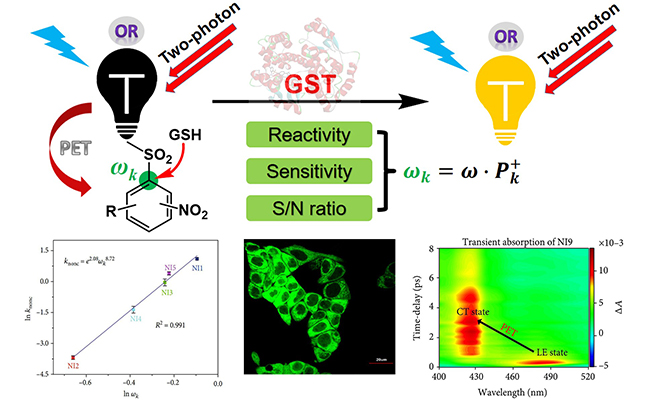Recently, Prof. HAN Keli's group in cooperation with Prof. PIAO Hailong's group from the Dalian Institute of Chemical Physics (DICP) of the Chinese Academy of Sciences proposed a semi-quantitative molecular designing strategy for fluorescent probes of glutathione S-transferases (GSTs) detection, in terms of the local electrophilicity index quoted from the conceptual density functional theory.
As phase II detoxifying enzymes, GSTs catalyze the nucleophilic attack of the sulfhydryl of glutathione (GSH) on an electrophilic center of diverse substrates. A variety of isoenzymes of GSTs are frequently found to overexpress in many tumor cell lines, especially in anticancer drug-resistant ones. Hence, sensitively and specifically monitoring GST activities is urgently needed.
To obtain a practical high-performance fluorescent probe for GSTs, it's necessary to reduce the background nonenzymatic reaction noise. However, there is usually a trade-off between sensitivity and background noise. Thus, the key point lies on the fine-tuning of the nonenzymatic reactivity with GSH.

Semi-quantitative molecular designing of high-performance two-photon fluorescent probes for GSTs. (Image by ZHANG Xuexiang)
The conceptual density functional theory (CDFT) starts with theorem that the ground state properties of a molecule can be determined by its electronic density in ground state, and gives the specific physical definitions and expressions of those concepts related to chemistry, facilitating quantitative calculations and evaluations of these conceptual physical quantities.
Based on the above-mentioned theory and the nucleophilic aromatic substitution (SNAr) mechanism of GST catalyzed reactions, the researchers introduced the local electrophilicity index ωk from CDFT to GST fluorescent probe designing to depict its background reaction noise, thus achieving fine-tuning the reactivity.
Kinetic study on nonenzymatic reactions revealed that the parameter ωk is competent to quantify and predict the background reactivity of probes with GSH, and kinetic study on enzymatic reactions indicated that the value of ωk can represent the sensitivity of a probe to GST on the whole.
Compared with the sensitivity kcat corresponding to enzymatic reactions, the background noise knonc corresponding to nonenzymatic reactions was more sensitive to ωk. It proved self-consistently that there did exist an operation space for achieving the reduce of noise while maintaining a certain high sensitivity by finely tuning ωk.
Additionally, apart from the optimization of the reaction/recognition mechanism, the photoinduced electron transfer (PET) process in terms of the photoluminescence mechanism also contributed to the low background autofluorescence, which was confirmed by femtosecond transient absorption spectra and theoretical calculations based on time-dependent density functional theory.
This work provides a new way for semi-quantitatively designing fluorescent probes or drug molecules related to SNAr reaction and it was published in the Research.
This work was supported by the National Natural Science Foundation of China, the Scientific Instrument Developing Project of the Chinese Academy of Sciences, the Liao Ning Revitalization Talents Program, and the Dalian City Foundation for Science and Technology Innovation. (Text by ZHANG Xuexiang)